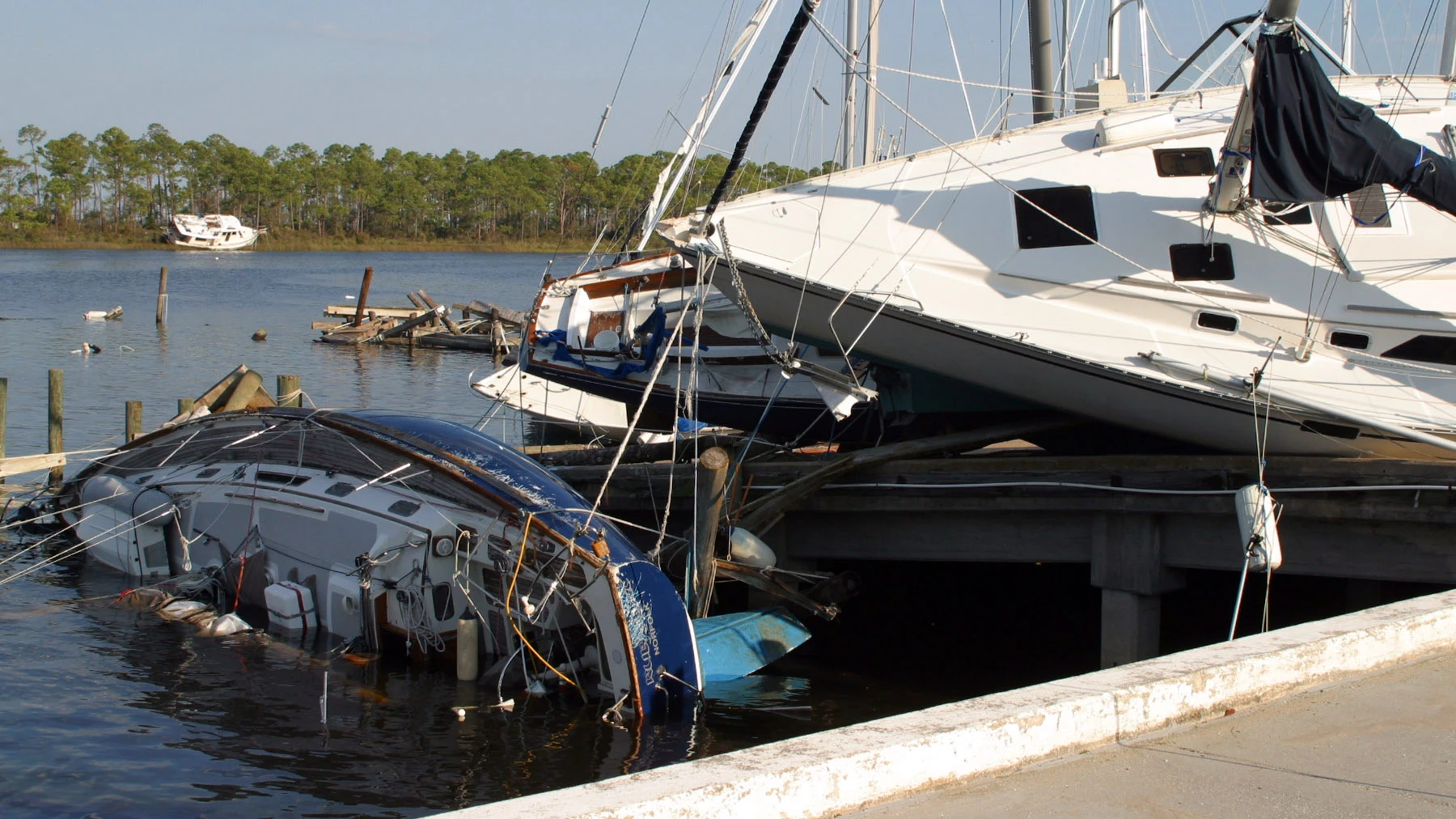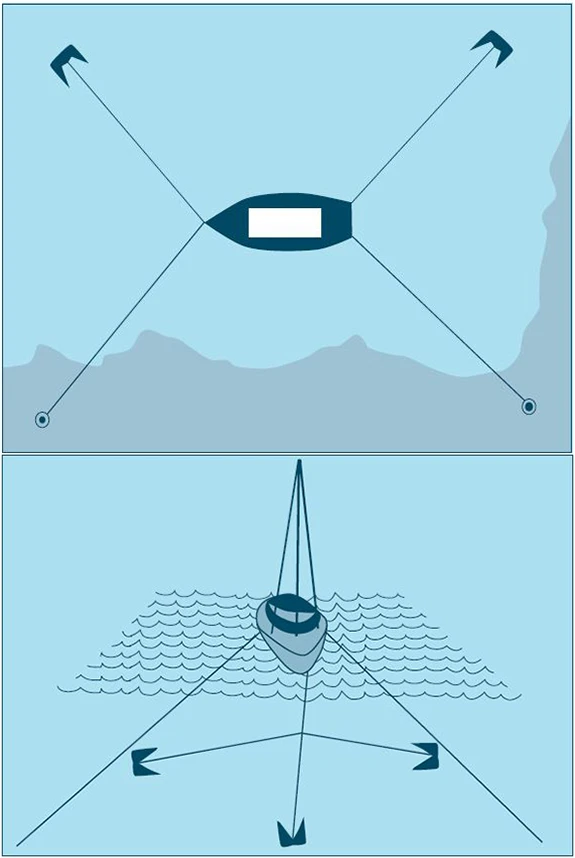Hurricanes can wreak all kinds of havoc on boats. Powerful winds can scatter boats ashore, and smashing seas can sink or damage them. Storm surges can even lift entire floating docks above their pilings or knock boats off their cradles. Therefore, prudent boat owners need to dedicate special attention to securing their boat as part of their overall hurricane plan.

Bear in mind, there is no such thing as a generic hurricane plan – individual circumstances determine where to secure your boat and how much prep time you will need. Nonetheless, two general pieces of advice apply to everyone. First, never plan to ride out the storm in your boat! Second, do not return to check on your boat once wind and waves pick up. Sadly, many deaths attributed to hurricanes are boaters that drowned while riding out the storm or trying to save their boats.
When to Plan, When to Act
Create or update your plan well before a storm has even been spotted in the Caribbean basin, such as during National Hurricane Preparedness Week or when Atlantic hurricane season starts in June. If your boat is in a marina, learn their plan, give them a copy of your plan, and have a clear understanding about your responsibilities. Some marinas may not be able to haul your boat out as the storm approaches or may have their hands full in the chaos. Out of town boat owners may need to delegate a local captain or caretaker to help carry out or oversee some aspects of their plan.
Identifying where to secure your boat is the key to your plan. Consider your options based on several potential storm intensities and tracks. The location dictates many of the specifics in your plan, including supplies, actions, and the lead time for preparing when a storm is approaching. Estimate travel time by boat if it’s an on-water location, or by car if trailering it to higher ground. Factor in traffic congestion and any bridges or low-lying roads that may close as storms approach. You should start moving your vessel 48-72 hours before a hurricane is estimated to strike, which puts it before the time when a Tropical Storm or Hurricane Watch is issued.
Securing Your Trailer and Boat
Pulling your boat to high, dry land is more secure than the water, especially for small, open crafts and high performance powerboats. If you can trailer it, store your boat well away from low-lying coastal areas. Plan to tie down, weigh down, and strip the boat for transit, and inspect your trailer and keep it in good operating condition throughout the hurricane season. Low elevation and small lot sizes in Monroe County limit local options, so consider other options on the mainland. Do you have friends with land or a garage that you can use? Be sure to have alternative options in case they, too, are in the cone of the oncoming hurricane. If you need to rent a dock or storage space elsewhere, make arrangements early.

Small boats that must be left in the open must be well tied down, with heavy line or chain to screw anchors in the ground, in a location that is as safe as possible from wind in all four directions. Keep it away from trees and power lines. The leeside of a building may be a good spot, as it will protect the vessel from at least one direction. Drain plugs must be removed. Some small vessels may be handled differently, by filling them 1/3 to 1/2 with fresh water and placing directly on the ground.
Removing Valuables and Sealing the Boat
Boats on shore, in transit, and on the water all need to be stripped of potential flying debris and pollution hazards. Valuable personal effects and the ship’s papers are among the first things that a boat owner may remember to remove from a boat, but any movable item such as canvas, sails, dinghies, galley fuel, cushions, biminis and roller furling sails can become flying debris and should be removed. Take down the mast whenever possible and lash down tillers, wheels, booms, and other items you can’t remove. Secure all hatches and portals and cover windscreens. Remove electronics and shut down the electrical system except the bilge pump if you are on the water. Remove fuels if you are storing the boat on shore.
As you review the tasks needed to strip the boat, create a list of items to remove, and inventory what is left on board. Determine how much time it takes to clear and tie down your boat through practice. Going through the motions also helps you identify your equipment needs and improve your plan.
Safe Havens and Hurricane Holes
Scout out your safe haven when developing your hurricane plan. If you must get there by boat, plan enough time and ensure fuel tanks are filled, fuel filters are cleaned, batteries are charged, cockpit drains are free and clear, and fire extinguishers and life jackets are in working order. Plan your means of exit, for example, the dinghy may need to remain on board until the end. Keep a radio handy for calling bridges and weather hotlines. Weather information is broadcast via NOAA Weather Radio on 162.400 MHz (Key West - Marathon), 162.450 MHz (Grassy Key - Key Largo), and 162.425 MHz (Miami-Dade region).
Canals and marinas near the ocean may experience storm surges which can reach 10 or more feet, and can beat boats against the dock or impale them on pilings. If you moor at a dock, ensure it has adequate protection from open seas as well as tall, sturdy pilings that accommodate the rising waters of storm surge. Heavy duty fender boards and the proper tie-off techniques may help limit damage. Mooring in the center of a canal is better than a dock, but must be done after all other boats have left. Your vessel can not impede other vessels. Use a four-point system of double mooring lines secured to both shores, port and aft. Do not raft vessels together at moorings or docks, as they inflict damage when they batter each other.
Hurricane holes are a time-honored tradition with captains around the Caribbean. They are narrow inlets with deep waters that are surrounded by trees or features that offer protection from the wind. If you plan on using a hurricane hole, adapt the rules for marinas to the setting, tying double and triple lines, short and long, high enough to account for rising waters and battering winds. Special anchoring methods can also improve the chances your boat will avoid damage.
Tying Down
Tie down boats with double and triple mooring lines. Longer spring lines should be tightest and shorter lines should be loosest. Attach lines high on pilings to allow for tides and storm surge. Lines will stretch and chafe, so use chafing gear such as neoprene hoses to protect lines at contact points. Install fenders to buffer the vessel from rubbing the pier, pilings, and other boats.

Once you’ve identified your safe haven and practiced securing your vessel, create a diagram of the proposed docking/mooring arrangement as part of your hurricane plan. Gather and purchase all the equipment you will need at the beginning of hurricane season so it’s ready when needed. Storing it on board will make it handy for later.